Lichen: 10 reasons to make it your new favourite hobby for 2016
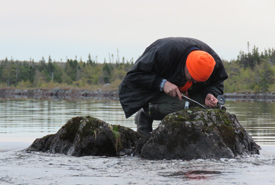
Troy McMullin, lichenologist from the University of Guelph, takes a lichen sample from a rock. (Photo by NCC)
As we enter into the crisp, blank canvas of a new year, many of us have laid out plans and promises to become fitter, smarter, nicer, happier, richer versions of ourselves. Some plans for self-improvement may include trying a new activity like brewing craft beer or learning the banjo (I swear this is the year), but I’m willing to bet few people have added "learn more about lichens" to their resolution list. Read on to find out why you should consider adding it to yours.
Working with the Nature Conservancy of Canada (NCC) this year, I have learned more about lichen than I ever imagined I would care to. In Newfoundland and Labrador, NCC has conserved property on the Avalon Peninsula within the Fog Forest Natural Area — a known hotspot of lichen diversity.
Lichens are a combination of two separate organisms — a fungus and an algae (or cyanobacteria) — and occur in an unimaginable variety of shapes, colours and places. Before I learned about lichens, to me they did not amount to much more than perplexing, leafy growths on trees or flaky, colourful smears on rocks. Add to that perception their suite of tongue-twisting scientific names and it’s not hard to see why lichens could seem daunting as a casual pastime.
So last fall when my colleague and I heard that University of Guelph lichenologist (lichen specialist), Troy McMullin, was visiting the province and had an interest in the lichens in our project area, we took the opportunity to reach out to him and see if he would demystify the complexities of lichen for us.
With McMullin as our guide, we embarked on a two-day trip travelling through forests, across rivers and up mountains to hunt for lichens in the Fog Forest Natural Area. Our group was on the lookout for several critically rare arboreal lichen species as well as subarctic lichen species thought to thrive in our island’s unique climatic conditions. McMullin showed us where to look for different types of lichens and taught us the name of each new lichen we encountered.
Then he patiently repeated each new lichen name again, and then again, and again.
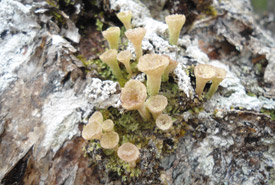
Mealy pixie cup lichen (Photo by Mac Pitcher)
I couldn’t believe the diversity of lichens we spotted. At times, lichen-searching felt like a scavenger hunt as we carefully scanned tree trunks gathering clues indicating that we were getting closer and closer to finding rare boreal felt lichen. At other moments, lichen-hunting felt more like stumbling across a recently burst lichen-piñata, where all we had to do was take in the richness of all the lichen species.
I finished our trip feeling almost like I had learned the language of some secret miniature world and gained a special glimpse into the furtive realm of lichens. It turns out that my apprehensions about lichenizing (studying lichens, especially in their natural habitat) were unjustified and that all I needed was a gentle push to get me started.
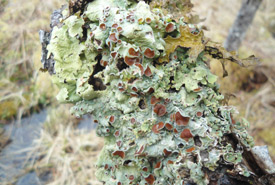
Smooth lungwort lichen (Photo by Mac Pitcher)
Here are my top 10 reasons why I plan to get out looking for lichens in 2016 (my gentle push to get you started):
1. You need minimal gear.
You don’t need more than your eyes to start spotting lichens. A hand lens and good field guide book will help you examine your discoveries in more detail and help you learn their names. Consider bringing a pencil, notebook and camera to record the many species you see!
2. You can find lichens almost everywhere.
Lichens can occur on almost any substrate and in any environment (some lichens can even survive in space!). You can certainly travel to remote, exotic rainforests or mountain ranges to discover lichens, but you are also likely to make some interesting discoveries not far from your own backyard.
Start your search looking on surfaces that haven’t been disturbed in a long time, such as the bark of mature trees, gravestones or large rocks.
3. It’s like snorkeling in coral reefs, without getting wet.
Without even putting on a wetsuit you can discover long-lived, slow growing lichens in their array of beautiful colours and awesomely bizarre forms. Much like coral reefs, lichens offer a lot to discover. There are even lichens called coral lichens.
4. Lichens stay where they are.
Lichens won’t fly, run or swim away just when you finally get your tripod set up and your lens focus just right. Lichens, for the most part, are firmly attached to their substrate and make excellent subjects for photography and up-close observation.
5. It’s a fair weather hobby.
Winter or summer, morning or night, sunshine or rain, you can choose when you want to go looking for lichens. They aren’t going anywhere too quickly.
6. Lichens come in an amazing variety.
Just when you think you’ve seen it all, there is more to discover once you realize that that twig, smear or stain is actually a lichen.
7. It’s a chance to get creative with names.
Despite the exceptional diversity and near-omnipresence of lichens, they are relatively poorly understood. As a result, many don’t have common names.
This is an opportunity to get creative, folks! Perhaps you will come up with a common name of your own that sticks; something like fairy-puke lichen or peppermint drop lichen (I promise you, these are real lichen names).
8. Great new lichen guidebooks make lichen-hunting easy.
Until recently, there weren’t many simple-to-use lichen resources available. More and more guidebooks, complete with stunning, high-quality photographs and easy-to-understand descriptions, are becoming available for lichen-likers of all experience levels.
9. You can impress your friends.
Make your friends think you are pretty much a wizard by knowing where to spot the tiniest and strangest of lichens.
10. Lichens inspire art.
In their array of unusual forms, patchwork arrangements and striking colours, it’s no stretch to see how lichens could inspire imaginations.
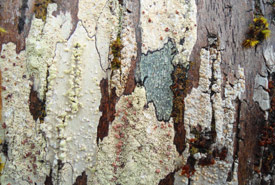
How many kinds of lichen can you spot in this picture? There are at least five different types. (Photo by Mac Pitcher)
A wealth of lichens to discover
Overall, led by McMullin, our group noted the presence of more than 50 lichen species, including several subarctic species and the globally rare boreal felt lichen.
At NCC we are grateful when researchers and field professionals show an interest in our project areas, because it gives us the opportunity to learn more about the lands we protect. The Nature Conservancy of Canada has many great nature reserves filled with a diversity of plants and animals, but organisms like lichens often go unnoticed; largely because they are poorly understood.
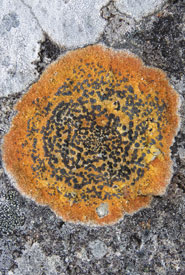
This lichen is called orange boulder lichen (Porpidia flavocaerulescens). I think I would have picked the name ‘chocolate chip cookie lichen’. (Photo by NCC)
This new , get outside and connect with nature. The Nature Conservancy of Canada welcomes individuals and families to spend time on some of the more than 13,000 acres (5,260 hectares) we have helped protect in Newfoundland and Labrador, whether it’s to look for lichens, spend time with family and friends or simply to enjoy the natural beauty of the province.
We also invite scientists and academics who have a particular interest in habitats, plants and wildlife to work with us to conduct important research.
Click here to learn more about the Nature Conservancy of Canada’s work in Newfoundland and Labrador.


